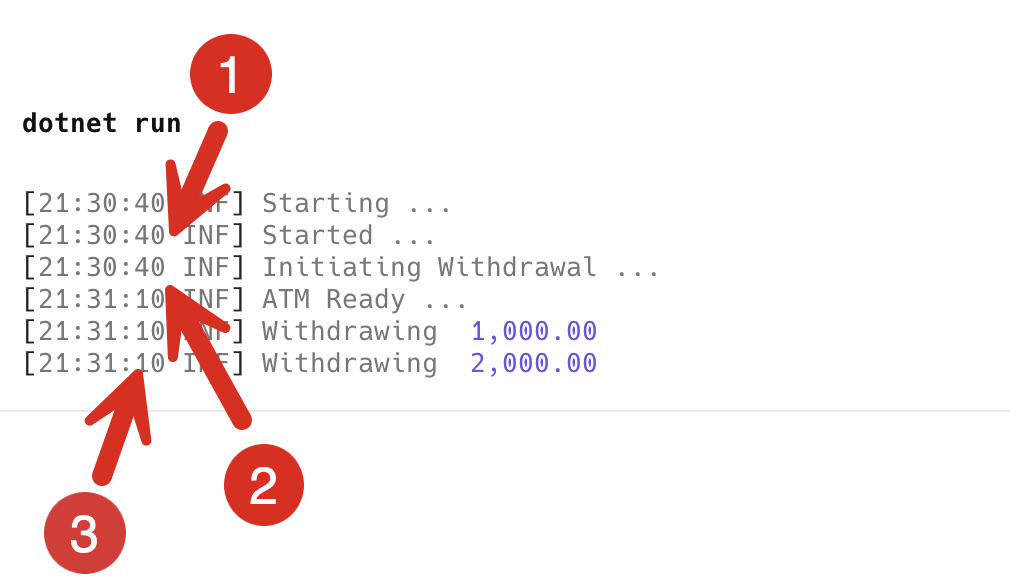Lazy Initialization With System.Lazy
[C#, .NET]
Initialization of a class, where we set its initial state, is something we do all the time, and usually don’t think too much about as it is very routine.
Let us take an example of this class that models an ATM machine:
using Serilog;
public sealed class ATM
{
public decimal Balance { get; private set; }
public ATM(decimal balance)
{
Balance = balance;
Log.Information("ATM Ready ...");
}
public void Withdraw(decimal amount)
{
if (amount < Balance)
{
Log.Information("Withdrawing {Amount:#,0.00}", amount);
Balance -= amount;
}
else
Log.Error($"Insufficient ATM balance");
}
public void Deposit(decimal amount)
{
Log.Information("Depositing {amount:#,0.00}", amount);
Balance += amount;
}
}
In our program, we are using Serilog and logging to the console using Serilog.Sinks.Console package.
Then, let us take a look at this class that models an ATM Booth.
public sealed class ATMBooth
{
public ATM ATM { get; }
public ATMBooth()
{
ATM = new ATM(100_000);
}
}
So far, so good.
Now, suppose it was expensive to initialize an ATM. Assume the constructor was as follows:
public ATM(decimal balance)
{
// Simulate a lengthy process
Thread.Sleep(TimeSpan.FromSeconds(30));
Balance = balance;
Log.Information("ATM Ready ...");
}
We then have this simple program:
using Serilog;
Log.Logger = new LoggerConfiguration()
.WriteTo.Console()
.CreateLogger();
Log.Information("Starting...");
// Create an ATM Booth
var booth = new ATMBooth();
booth.ATM.Withdraw(1_000);
If we run this program, we will see the following:
[21:07:24 INF] Starting...
[21:07:54 INF] ATM Ready ...
[21:07:54 INF] Withdrawing 1,000.00
If we look closely:

We can see here that for 30 seconds, the program is unusable, as it is initializing the ATM.
This presents a problem. It is currently OK because we have a withdrawal request, but what if there wasn’t? Then, there would be no need to initialize the ATM.
We could then decide to initialize our ATM only when we actually need it.
We can modify our ATM class as follows:
public sealed class ATMBooth
{
// Initially this is null
private ATM? _atm;
public ATM ATM
{
get
{
// Check if the field is null
if (_atm == null)
{
// If it is, create a new one
_atm = new ATM(100_000);
}
// Return the field
return _atm;
}
}
}
A couple of changes here:
- The constructor has been removed
- We have introduced a nullable private field,
_atm - When accessed, the public property,
ATM, checks if_atmisnull. If it is, it creates a new ATM. Otherwise, it returns the existing_atminstance.
We can then tweak our program slightly to demonstrate a few things:
Log.Information("Starting ...");
// Create an ATM Booth
var booth = new ATMBooth();
Log.Information("Started ...");
Log.Information("Initiating Withdrawal ...");
// Do a withdrawal
booth.ATM.Withdraw(1_000);
// Do a second withdrawal
booth.ATM.Withdraw(2_000);
If we run the program we should see the following:
[21:30:40 INF] Starting ...
[21:30:40 INF] Started ...
[21:30:40 INF] Initiating Withdrawal ...
[21:31:10 INF] ATM Ready ...
[21:31:10 INF] Withdrawing 1,000.00
[21:31:10 INF] Withdrawing 2,000.00
If we look closely at the timestamps:

- The initial 30-second hit at initialization is gone.
- The 30-second initialization hit was taken when we attempted to make the first withdrawal.
- The subsequent withdrawal is instantaneous.
This is a much better design, but it has one fatal problem - it is not thread-safe. If we had several withdrawals to make and wanted to do them in several threads, we have a potential edge case when multiple threads attempt to access an ATM at the same time, find it is null, and then there are potentially multiple attempts to create an ATM.
This section, in particular, is the problem:
// Check if the field is null
if (_atm == null)
{
// If it is, create a new one
_atm = new ATM(100_000);
}
A solution to this problem is to use a Lock, as discussed in a previous post, like this:
public sealed class ATMBooth
{
// Initially this is null
private ATM? _atm;
// Create a lock object
private readonly Lock _lock = new();
public ATM ATM
{
get
{
if (_atm == null)
{
// Do our null check & creation in a scope
using (_lock.EnterScope())
{
// Check if the field is null
if (_atm == null)
{
// If it is, create a new one
_atm = new ATM(100_000);
}
}
}
// Return the field
return _atm;
}
}
}
A couple of things to notice here:
- We create a
Lockat theATMBoothlevel as aprivatereadonlyfield - In the ATM property getter, we first check if the private
_atmfield isnull. If it isn’t, we immediately return the instance. If not, we use the lock to control access to the field as we initialize it.
This pattern is called double-checked locking.
There is an even better solution to this problem that saves us all the heavy lifting of having to manage creaton of the object and the managing of locks ourselves - functionality in the System.Lazy class.
We can rewrite our class as follows:
public sealed class ATMBooth
{
// Indicate we need lazy initialization for our ATM
private Lazy<ATM> _atm;
public ATMBooth()
{
// Lazily initiate our ATM, and indicate we want it thread-safe
_atm = new Lazy<ATM>(() => new ATM(10_000), true);
}
// Return the value from our Lazy object when requested
public ATM ATM => _atm.Value;
}
The code is much simpler. The Lazy object and the delegate that tells it how to initialize our ATM class do the heavy lifting.
TLDR
The Lazy class offers the ability to indicate objects that we want to be initialized lazily, and we can indicate thread-safety of the same.
The code is in my Github.
Happy hacking!